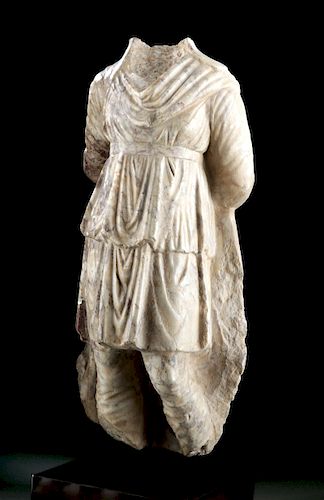Roman Pavonazzetto Marble Dacian Captive, ex Christie's
Lot 74
About Seller
Artemis Gallery
686 S Taylor Ave, Ste 106
Louisville, CO 80027
United States
Selling antiquities, ancient and ethnographic art online since 1993, Artemis Gallery specializes in Classical Antiquities (Egyptian, Greek, Roman, Near Eastern), Asian, Pre-Columbian, African / Tribal / Oceanographic art. Our extensive inventory includes pottery, stone, metal, wood, glass and textil...Read more
Estimate:
$30,000 - $50,000
Absentee vs Live bid
Two ways to bid:
- Leave a max absentee bid and the platform will bid on your behalf up to your maximum bid during the live auction.
- Bid live during the auction and your bids will be submitted real-time to the auctioneer.
Bid Increments
| Price | Bid Increment |
|---|---|
| $0 | $25 |
| $300 | $50 |
| $1,000 | $100 |
| $2,000 | $250 |
| $5,000 | $500 |
| $10,000 | $1,000 |
| $20,000 | $2,500 |
| $50,000 | $5,000 |
| $100,000 | $10,000 |
| $200,000 | $20,000 |
About Auction
By Artemis Gallery
Sep 26, 2019
Set Reminder
2019-09-26 10:00:00
2019-09-26 10:00:00
America/New_York
Bidsquare
Bidsquare : Exceptional Day 1: Antiquities & Asian Art
https://www.bidsquare.com/auctions/artemis-gallery/exceptional-day-1-antiquities-asian-art-4437
Day 1 of an important 2-day auction featuring exceptional, museum-worthy examples of Egyptian, Greek, Etruscan, Roman, Viking, Russian, Near Eastern, as well as Asian Art from China, Japan, Thailand, Vietnam, Burma and India. Artemis Gallery info@artemisgallery.com
Day 1 of an important 2-day auction featuring exceptional, museum-worthy examples of Egyptian, Greek, Etruscan, Roman, Viking, Russian, Near Eastern, as well as Asian Art from China, Japan, Thailand, Vietnam, Burma and India. Artemis Gallery info@artemisgallery.com
- Lot Description
Roman, Imperial Period, ca. 1st to 2nd century CE. An expertly carved statue of a bound prisoner, dressed in a long tunic-like garment and trousers, with arms behind the back where they meet a pillar. The figure appears to be standing in contrapposto as the left knee is bent to indicate a weight shift. Despite the fact that the head and lower legs are missing, this pose with arms behind the back suggests that the figure represents a prisoner, perhaps one of the Dacians captured by Trajan's army in what we refer to today as the Carpathian mountains. A spectacular statue of a captive barbarian, and the Pavonazzetto marble (a stunning variety of Carrara marble) is inherently beautiful presenting purple and plum red veining throughout. See more about the historical context of this piece as well as the rarity of Pavonazzetto marble below. Size: 8.5" L x 9" W x 20" H (21.6 cm x 22.9 cm x 50.8 cm); 24.25" H (61.6 cm) on included custom stand.
According to Andrew Curry who wrote a National Geographic article that analyzed the destruction delineated on the Trajan Column wrote, "Near the top of the column is a glimpse of the denouement: a village put to the torch, Dacians fleeing, a province empty of all but cows and goats. . . The two wars must have killed tens of thousands. A contemporary claimed that Trajan took 500,000 prisoners, bringing some 10,000 to Rome to fight in the gladiatorial games that were staged for 123 days in celebration." Curry interviewed archaeologist Gelu Florea who has excavated the site of the Dacian's defeat. Florea stated, "Everything was dismantled by the Romans. There wasn't a building remaining in the entire fortress. It was a show of power—we have the means, we have the power, we are the bosses." (https://www.nationalgeographic.com/trajan-column/article.html)
This is an ex-Christie's piece (ex-Christie's, New York "Antiquities" auction - sale 14356, October 25, 2017, lot 51 - listed with estimate of $60,000 to $90,000). According to Christie's description, "Pavonazzetto (Marmo Phrygium in Latin) is a fine-grained marble with purplish veins and inclusions, which historically was imported to Rome from Docimium (located in central Phrygia in Asia Minor). Due to the quarries of this distinctive marble being of considerable distance from navigable waterways, pavonazzetto was extremely expensive in antiquity. Despite this, or perhaps as a result, pavonazzetto was particularly fashionable from the 1st Century A.D. onwards, when it was most commonly employed for the carving of supporting statues representing an Oriental type of figure dressed in foreign costume, as seen in the present example. The extremities were frequently finished in another material, typically white marble, as evinced here by the shoulder cavity which was designed for the insertion of now-missing separately-made head. The present example likely depicts a Dacian captive, and may take its inspiration from colossal statues which decorated Trajan's Forum in Rome (see M. De Nuccio and L. Ungaro, I marmi colorati della Roma imperiale, pp. 333-340, nos. 31-40)."
Provenance: private East Coast, USA collection; ex-Christie's, New York "Antiquities" auction (sale 14356, October 25, 2017, lot 51); ex-private collection, acquired prior to 1995 from Fortuna Fine Arts, New York, New York, USA
All items legal to buy/sell under U.S. Statute covering cultural patrimony Code 2600, CHAPTER 14, and are guaranteed to be as described or your money back.
A Certificate of Authenticity will accompany all winning bids.
We ship worldwide and handle all shipping in-house for your convenience.
#149155A fragment from a larger sculpture - missing head and lower legs - but a strong representation nonetheless. Losses to peripheries and high pointed areas as expected.Condition
- Shipping Info
-
All shipping is handled in-house for your convenience. Your invoice from Artemis Gallery will include shipping calculation instructions. If in doubt, please inquire BEFORE bidding for estimated shipping costs for individual items.
-
- Buyer's Premium



 EUR
EUR CAD
CAD AUD
AUD GBP
GBP MXN
MXN HKD
HKD CNY
CNY MYR
MYR SEK
SEK SGD
SGD CHF
CHF THB
THB















